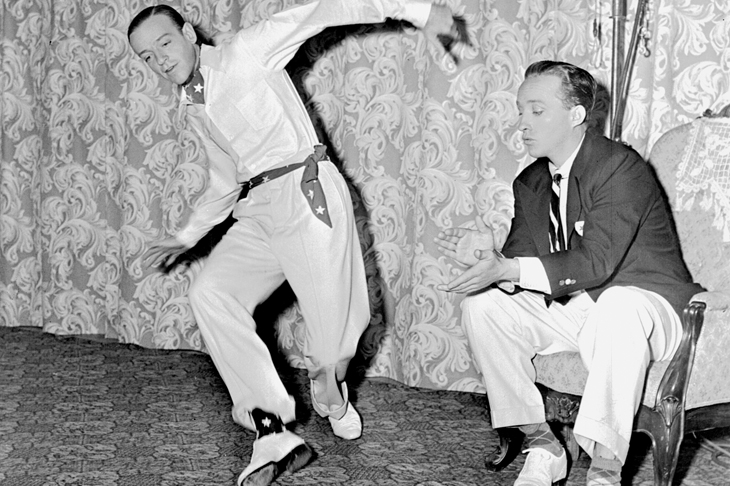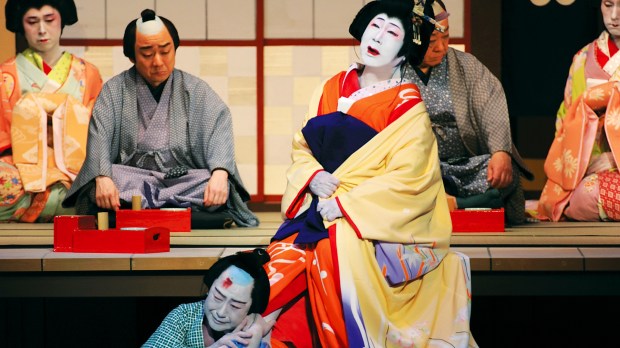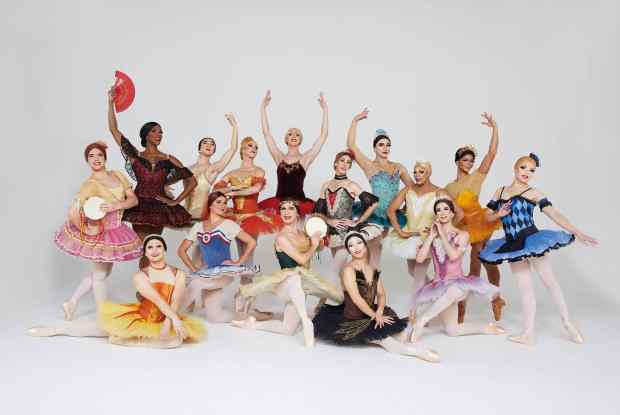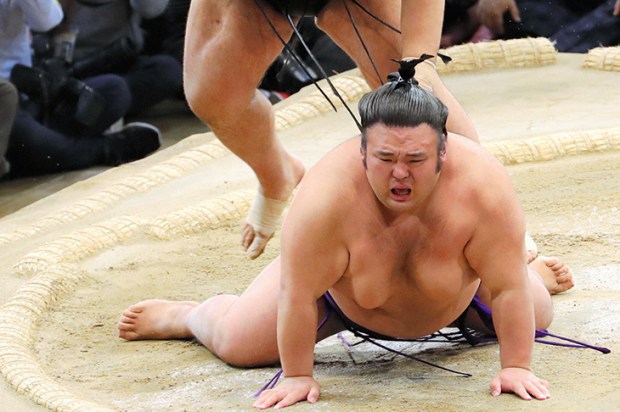Fire up YouTube on the iPad, tap in ‘tap’, then wave goodbye to the rest of your day: clip after clippety-clip of the best and brightest stars rattling out impossible rhythms: Fred Astaire dancing on the ceiling; Fayard and Harold Nicholas taking the stairs one split jump at a time; Gene Kelly singing (and dancing) in the rain.
The American actor, writer and entertainer Clarke Peters (anything from The Wire to Five Guys Named Moe) was never dragged to tap-dancing classes as a boy in the late 1950s — ‘it was more ballet and jazz by then’ — but he remembers ‘trying to pick up moves from the films. I think I do what I do because of Gene Kelly. He wasn’t a great tap dancer but I loved his athleticism, his style.’
Peters is modest about his own powers — ‘I’m the best tapper in the world in my kitchen’ — but his background in musicals and revue and his affection for the dancers of old made him a logical choice to present BBC4’s Tap America, one of a sudden rash of dance programmes crowding the May schedule.
The hour-long nostalgia-fest is vaguely reminiscent of the old MGM That’s Entertainment! compilations but dresses upthe archive footage as social history with the help of a team of dance commentators and academics (UCLA has its own ‘tap scholar’, apparently). These tell us little we didn’t already know about the roots of tap dancing, which was essentially the synthesis of two US immigrant traditions: the African rhythms imported by the slaves and the stiff-bodied step-dancing of the Irish jig. Black ‘buck dancers’ elaborated and refined this new, multirhythmic form which was widely admired and routinely copied, not least by the infamous blackface minstrels of the 1830s (and beyond).
All dancers are thieves. They see a move they like and they can’t help themselves: they pinch it, polish it, speed it up (or slow it down) and serve it up again as their own work. These magpie habits can be seen as ‘cultural appropriation’ but Brian Seibert, the best of Tap America’s pundits and author of the definitive tap history What the Eye Hears, knows that this trade in steps was part of tap’s creative life blood: ‘People were stealing from each other all the time. It’s built into the form.’
This copycat behaviour became one of the great tropes (some might say clichés) of tap performance: the Challenge Dance where hoofers take turns to replicate and then embellish one another’s moves. There’s a whiff of ‘trading taps’ in almost every Astaire/Rogers duet and you see it again when Bill ‘Bojangles’ Robinson teaches the seven-year-old Shirley Temple a simplified version of his signature stair dance in 1935’s The Little Colonel.
The golden age of tap dancing in the 1920s and 1930s coincided with the dawn of sound cinema and Hollywood greedily imported variety’s finest. At first the exhibition dancers were used merely to liven upa romantic comedy — Fred and Ginger were not the stars of Flying Down To Rio, their first film together — but dancing was soon taking centre stage and you didn’t have to be a virtuoso.
Busby Berkeley discovered his unique gift for precision ensembles while devising drill displays for the US army during the first world war and his cinematic extravaganzas were crafted from the most humdrum steps. The legendary 13-minute ‘Lullaby of Broadway’ sequence from Gold Diggers of 1935 has 100 hoofers rattling across an Escher-like series of platforms and staircases. This glorious scene is a triumph of logistics but the choreography — little more than variations on an eight-bar rhythm step — is hypnotically simple.
The public’s appetite for tap dancing seemed inexhaustible but it wasn’t. After the second world war there was a steady decline and the beginning of what Tap America dubs ‘the Great Tap Drought’ when tap all but disappeared from the silver screen. Audiences in general found tap and its music old-fashioned and the younger black generation of African Americans was almost embarrassed by the great black entertainers of the past. Tap had a tainted image: ‘It was Uncle Tom, demeaning, minstrel-like. It was something they wanted to forget.’
A few wiser talents kept the flame alive. The feather-footed Arthur Duncan (one of Tap America’s interviewees) had a semi-regular TV slot on The Lawrence Welk Show during the 1960s and 1970s and the multitalented Sammy Davis Jr, master of what aficionados call ‘close tap’, invariably included a bravura routine in his one-man shows.
By the late 1970s, a new wave of dancers and dancemakers, mostly white, often female, were attracted by tap’s improvisatory vibe and began hauling old hoofers out of retirement to teach workshops. In 1984 Francis Ford Coppola featured the dancer Gregory Hines in The Cotton Club and a year later Hines danced a duet with the Russian ballet superstar Mikhail Baryshnikov in the movie White Nights, catapulting tap back into the mainstream.
Tap, like ballet or jazz or classical music, has its own family tree of heroes, mentors and teachers. As a child star, Hines performed on the same circuit as the Nicholas Brothers. He learned a lot from his idol, Sammy Davis, and would in his turn teach Savion Glover, whom he described as ‘possibly the best tap dancer that ever lived’.
Glover made his Broadway debut aged 11. He starred in several films, and his mind-bending speed and facility were captured to create the flippers of the animated penguin in Happy Feet. But, despite this crowdpleasing turn (and its sequel), Glover canbe a hard dancer to love. ‘I don’t tap dance for the sake of applause. I don’t tap dance for the sake of spectacle,’ he once claimed, ‘I tap dance for equality.’
Glover’s rhythmic sophistication never fails to impress but his self-absorbed performance style can be alienating — if not downright dull. The New York Times’s Alastair Macaulay could not fail to be in awe of the star’s ‘hummingbird’ footwork but wrote: ‘It is hard to think of a celebrated dancer performing today who is more tedious, more devoid of stage sense.’ Ouch.
Sadly (and rather bizarrely) Glover does not feature in the Tap America documentary and his absence leaves a strange hole in the film. ‘He was one of the people I wanted to go to,’ admits Clarke Peters. ‘Unfortunately we couldn’t get hold of him. I was heartbroken.’
Glover is the ultimate tap purist (he’s been known to riff to Shostakovich). He won’t be dancing in the UK this year but there are plenty of teeth and smiles to be had down at the shallow end of the Tap renaissance from coach-party magnets like Australia’s Tap Dogs, who deliver blokey, jokey, undemanding hoofing on a building-site set.
The latest of these troupes, put together by a Tap Dog survivor, is The Tap Pack. Essentially housetrained Tap Dogs, the five chaps have ditched the hard hat, high-viz aesthetic in favour of a swift raid on Burton’s window. The besuited quintet clog doggedly through a dozen or more numbers (they sing, too) with energy and enthusiasm, but after a square-eyed day spent watching clips of Robinson and Kelly and Hines and Glover there is something rather exhausting about an evening of mid-range hoofing. They called it variety for a reason.
Got something to add? Join the discussion and comment below.
Get 10 issues for just $10
Subscribe to The Spectator Australia today for the next 10 magazine issues, plus full online access, for just $10.
You might disagree with half of it, but you’ll enjoy reading all of it. Try your first month for free, then just $2 a week for the remainder of your first year.














Comments
Don't miss out
Join the conversation with other Spectator Australia readers. Subscribe to leave a comment.
SUBSCRIBEAlready a subscriber? Log in